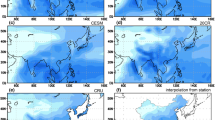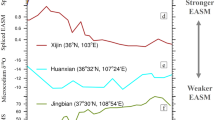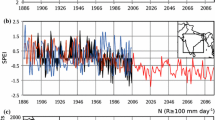Abstract
Early proxy-based studies suggested that there potentially occurred a “southern drought/northern flood” (SDNF) over East China in the mid-Holocene (from roughly 7000 to 5000 years before present). In this study, we used both global and regional atmospheric circulation models to demonstrate that the SDNF—namely, the precipitation increases over North China and decreases over the the lower reaches of the Yangtze River Valley—could have taken place in the mid-Holocene. We found that the SDNF in the mid-Holocene was likely caused by the lower SST in the Pacific. The lowered SST and the higher air temperature over mainland China increased the land-sea thermal contrast and, as a result, strengthened the East Asian summer monsoon and enhanced the precipitation over North China.
Similar content being viewed by others
References
Berger, A. L., 1978: Long-term variations of daily insolation and Quaternary climatic changes. J. Atmos. Sci., 35, 2362–2367.
Braconnot, P., and Coauthors, 2007: Results of PMIP2 coupled simulations of the mid-Holocene and Last Glacial Maximumpart 1: Experiments and large-scale features. Climate of the Past, 3, 261–277.
Brown, J., M. Collins, A. W. Tudhope, and T. Toniazzo, 2008: Modelling mid-Holocene tropical climate and ENSO variability: towards constraining predictions of future change with palaeo-data. Climate Dyn., 30, 19–36.
Cai, Y. L., Z. Y. Chen, W. Zhang, Z. Y. Guo, and Y. Chen, 2001: Climate fluctuation of the western Shanghai District by correspondence analysis since 8.5 kaB.P. Journal of Lake Sciences, 13, 118–126. (in Chinese)
Chang, C-P., Y. S. Zhang, and T. Li, 2000: Interannual and interdecadal variations of the East Asian summer monsoon and tropical Pacific SSTs. Part I: Roles of the subtropical ridge. J. Climate, 13, 4326–4340.
Chen, F., and J. Dudhia, 2001: Coupling an advanced land surface hydrology model with the Penn State-NCAR MM5 modeling system. Part I: Model implementation and sensitivity. Mon. Wea. Rev., 129, 569–585.
Chen, H. P., J. Q. Sun, and X. L. Chen, 2012: The projection and uncertainty analysis of summer precipitation in China and the variations of associated atmospheric circulation field. Climatic and Environmental Research, 17, 171–183. (in Chinese)
Chen, X. L., T. J. Zhou, and L. W. Zou, 2013: Variation characteristics of the Asian-Pacific Oscillation in boreal summer as simulated by the LASG/IAP climate system model FGOALS gl. Acta Meteorologica Sinica, 71, 23–37 (in Chinese).
Dallmeyer, A., and M. Claussen, 2011: The influence of land cover change in the Asian monsoon region on present-day and mid-Holocene climate. Biogeosciences, 8, 1499–1519.
Diffenbaugh, N. S., and L. C. Sloan, 2004: Mid-Holocene orbital forcing of regional-scale climate: A case study of western North America using a high-resolution RCM. J. Climate, 17, 2927–2937.
Ding, Y. H., Z. Y. Wang, and Y. Sun, 2008: Inter-decadal variation of the summer precipitation in East China and its association with decreasing Asian summer monsoon. Part I: Observed evidences. Int. J. Climatol, 28, 1139–1161.
Dudhia, J., 1989: Numerical study of convection observed during the winter monsoon experiment using a mesoscale twodimensional model. J. Atmos. Sci., 46, 3077–3107.
Fu, J. J., S. L. Li, and D. H. Luo, 2009: Impact of global SST on decadal shift of East Asian summer climate. Adv. Atmos. Sci., 26, 192–201, doi: 10.1007/s00376-009-0192-z.
Gao, X. J., J. S. Pal, and F. Giorgi, 2006: Projected changes in mean and extreme precipitation over the Mediterranean region from a high resolution double nested RCM simulation. Geophys. Res. Lett., 33, L03706, doi: 10.1029/2005GL024954.
Gao, X. J., Y. Shi, and F. Giorgi, 2011: A high resolution simulation of climate change over China. Science China: Earth Sciences, 54, 462–472.
Ge, Q. S., X. Z. Zhang, and J. Y. Zheng, 2013: Simulated effects of vegetation increase/decrease on temperature changes from 1982 to 2000 across the Eastern China. Int. J. Climatol., doi:10.1002/joc.3677. (in Press)
Hargreaves, J. C., and J. D. Annan, 2009: On the importance of paleoclimate modelling for improving predictions of future climate change. Clim. Past, 5, 803–814.
Harrison, S. P., J. E. Kutzbach, Z. Liu, P. J. Bartlein, B. Otto-Bliesner, D. Muhs, I. C. Prentice, and R. S. Thompson, 2003: Mid-Holocene climates of the Americas: a dynamical response to changed seasonality. Climate Dyn., 20, 663–688.
Hawkins, E., and R. Sutton, 2011: The potential to narrow uncertainty in projections of regional precipitation change. Climate Dyn., 37, 407–418.
He, S. P., 2013: Reduction of the East Asian winter monsoon interannual variability after the mid-1980s and possible cause. Chinese Science Bulletin, 58, 1331–1338.
Jiang, D. B., H. J. Wang, D. Helge, and X. M. Lang, 2003: Last glacial maximum over China: Sensitivities of climate to paleovegetation and Tibetan ice sheet, J. Geophys. Res., 108, 4102, doi: 10.1029/2002JD002167.
Jiang, D. B., X. M. Lang, Z. P. Tian, and T. Wang, 2012: Considerable model-data mismatch in temperature over China during the Mid-Holocene: Results of PMIP simulations. J. Climate, 25, 4135–4153.
Jiang, D. B., X. M. Lang, Z. P. Tian, and L. X. Ju, 2013: Mid-Holocene East Asian summer monsoon strengthening: Insights from Paleoclimate Modeling Intercomparison Project (PMIP) simulations. Palaeogeography, Palaeoclimatology, Palaeoecology, 369, 422–429.
Jin, L. Y., H. J. Wang, F. H. Chen, and D. B. Jiang, 2006: A possible impact of cooling over the Tibetan Plateau on the mid-Holocene East Asian monsoon climate. Adv. Atmos. Sci., 23, 543–550, doi: 10.1007/s00376-006-0543-y.
Ju, L. X., and X. M. Lang, 2011: Hindcast experiment of extraseasonal short-term summer climate prediction over China with RegCM3 IAP9L-AGCM. Acta Meteorologica Sinica, 25, 376–385.
Ju, L. X., H. J. Wang, and D. B. Jiang, 2007: Simulation of the Last Glacial Maximum climate over East Asia with a regional climate model nested in a general circulation model. Palaeogeography, Palaeoclimatology, Palaeoecology, 248, 376–390.
Knutti, R., and J. Sedlacek, 2012. Robustness and uncertainties in the new CMIP5 climate model projections. Nature Climate Change, 3, 369–373, doi: 10.1038/NCLIMATE1716.
Kutzbach, J. E., and Z. Liu, 1997: Response of the African monsoon to orbital forcing and ocean feedbacks in the middle Holocene. Science, 278, 440–443.
Lang, X. M., H. J. Wang, and D. B. Jiang, 2004: Extraseasonal short-term predictions of summer climate with IAP9LAGCM. Chinese Journal of Geophysics, 47, 19–24.
Liang, X. Z., 1996: Description of a nine-level grid point atmospheric general circulation model. Adv. Atmos. Sci., 13, 269–298.
Lin, Y. L., R. D. Farley, and H. D. Orville, 1983: Bulk parameterization of the snow field in a cloud model. J. Appl. Meteor. Climatol., 22, 1065–1092.
Liu, G., P. Zhao, and J. M. Chen, 2011: A 150-year reconstructed summer Asian-Pacific Oscillation index and its association with precipitation over eastern China. Theor. Appl. Clim., 103, 239–248.
Liu, Z, J. Kutzbach, and L. X. Wu, 2000: Modeling climate shift of El Nino variability in the Holocene. Geophys. Res. Lett., 27, 2265–2268.
Liu, Z., S. P. Harrison, J. Kutzbach, and B. Otto-Bliesner, 2004: Global monsoons in the mid-Holocene and oceanic feedback. Climate Dyn., 22, 157–182.
Luca, A. D., R. de Elia, and R. Laprise, 2013: Potential for small scale added value of RCM’s downscaled climate change signal. Climate Dyn., 40, 601–618.
Marzin, C., and P. Braconnot, 2009: The role of the ocean feedback on Asian and Africanmonsoon variations at 6 kyr and 9.5 kyr BP. Comptes Rendus Geoscience, 341, 643–655.
Mlawer, E. J., S. J. Taubman, P. D. Brown, M. J. Iacono, and S. A. Clough, 1997: Radiative transfer for inhomogeneous atmospheres: RRTM, a validated correlated-k model for the longwave. J. Geophys. Res., 102, 16 663–16 682, doi: 10.1029/97JD00237.
Otto-Bliesner, B. L., E. C. Brady, G. Clauzet, R. Tomas, S. Levis, and Z. Kothavala, 2006: Last glacial maximum and Holocene climate in CCSM3. J. Climate, 19, 2526–2544.
Shi, Y. F., and Coauthors, 1993: Mid-Holocene climates and environments in China. Global and Planetary Change, 7, 219–233.
Skamarock, W. C., and Coauthors, 2008: A description of the Advanced Research WRF version 3. Tech. Rep. NCAR/TN475+STR, National Center for Atmospheric Research, Boulder Co., 1–125.
Sun, H. C., G. Q. Zhou, and Q. C. Zeng, 2012: Assessments of the climate system model (CAS-ESM-C) using IAP AGCM4 as its atmospheric component. Chinese J. Atmos. Sci., 36, 215–233.
Sun, J. Q., and H. J. Wang, 2012: Changes of the connection between the summer North Atlantic Oscillation and the East Asian summer rainfall. J. Geophys. Res., 117, D08110, doi: 10.1029/2012JD017482.
Sun, Y., Y. H. Ding, and A. G. Dai, 2010: Changing links between South Asian summer monsoon circulation and tropospheric land-sea thermal contrasts under a warming scenario. Geophys. Res. Lett., 37, L02704. doi: 10.1029/2009GL041662.
Taylor, K. E., 2001: Summarizing multiple aspects of model performance in a single diagram. J. Geophys. Res., 106, 7183–7192.
Tian, Z. P., and D. B. Jiang, 2013: Mid-holocene ocean and vegetation feedbacks over East Asia. Clim. Past, 9, 2153–2171.
Wang, H. J., 1999: Role of vegetation and soil in the Holocene megathermal climate over China. J. Geophys. Res., 104, 9361–9367.
Wang, H. J., 2000a: The interannual variability of the East Asian Monsoon and its relationship with SST in a coupled Atmosphere-Ocean-Land climate model. Adv. Atmos. Sci., 17, 31–47.
Wang, H. J., 2000b: The seasonal climate and low frequency oscillation in the simulated mid-Holocene megathermal climate. Adv. Atmos. Sci., 17, 445–457.
Wang, H. J., 2001: The weakening of the Asian monsoon circulation after the end of 1970’s. Adv. Atmos. Sci., 18, 376–386.
Wang, H. J., 2002: The mid-Holocene climate simulated by a gridpoint AGCM coupled with a biome model. Adv. Atmos. Sci., 19, 205–218.
Wang, S. W. and J. B. Huang, 2006: The relationship between flood/drought and Chinese ancient civilization in mid-Holocene. Progress in Natural Science, 16, 1238–1244. (in Chinese)
Wang, T., and H. J. Wang, 2013: Mid-Holocene Asian summer climate and its responses to cold ocean surface simulated in the PMIP2 OAGCMs experiments. J. Geophys. Res., 118, doi: 10.1029/2012JD018845.
Wang, T., H. J. Wang, and D. B. Jiang, 2010: Mid-Holocene East Asian summer climate as simulated by the PMIP2 models. Palaeogeography, Palaeoclimatology, Palaeoecology, 288, 93–102.
Wicker, L. J., and W. C. Skamarock, 2002: Time splitting methods for elastic models using forward time schemes, Mon. Wea. Rev., 130, 2088–2097.
Xie, P. P., A. Yatagai, M. Y. Chen, T. Hayasaka, Y. Fukushima, C. M. Liu, and S. Yang, 2007: A gauge-based analysis of daily precipitation over East Asia. J. Hydrometeor., 8, 607–626.
Xu, Y., X. J. Gao, Y. Shen, C. H. Xu, Y. Shi, and F. Giorgi, 2009: A daily temperature dataset over China and its application in validating a RCM simulation. Adv. Atmos. Sci., 26, 763–772, doi: 10.1007/s00376-009-9029-z.
Yao, T. D., Z. C. Xie, X. L. Wu, and L. G. Thompson, 1991: Climatic-change since little ice-age recorded by Dunde ice cap. Science in China Series B, 34, 760–767.
Yokoyama, Y., A. Suzuki, F. Siringan, Y. Maeda, A. Abe-Ouchi, R. Ohgaito, H. Kawahata, and H. Matsuzaki, 2011: Mid-Holocene palaeoceanography of the northern South China Sea using coupled fossil-modern coral and atmosphereocean GCM model. Geophys. Res. Lett., 38, D20109, doi: 10.1029/2010GL044231.
Yu, E. T., 2013: High-resolution seasonal snowfall simulation over Northeast China. Chinese Science Bulletin, 58, 1412–1419, doi: 10.1007/s11434-012-5561-9.
Yu, E. T., H. J. Wang, and J. Q. Sun, 2010: A quick report on a dynamical downscaling simulation over China using the nested model. Atmos. Oceanic Sci. Lett., 3, 325–329.
Yu, E. T., H. J. Wang, J. Q. Sun, and Y. Q. Gao, 2012: Climatic response to changes in vegetation in the Northwest Hetao Plain as simulated by the WRF model. Int. J. Climatol., 33, 1470–1481.
Zeng, Q. C., and M. Mu, 2002: On the design of compact and internally consistent model of climate system dynamics. Chinese J. Atmos. Sci., 26, 107–113.
Zhang, R., D. B. Jiang, X. D. Liu, and Z. P. Tian, 2012: Modeling the climate effects of different subregional uplifts within the Himalaya-Tibetan Plateau on Asian summer monsoon evolution. Chinese Science Bulletin, 57, 4617–4626.
Zhang, Q. Y., S. Y. Tao, and L. T. Chen, 2003: The inter-annual variability of East Asian summer monsoon indices and its association with the pattern of general circulation over East Asia. Acta Meteorologica Sinica, 61, 559–568. (in Chinese)
Zhang, Y., and J. Q. Sun, 2012: Model projections of precipitation minus evaporation in China. Acta Meteorologica Sinica, 26, 376–388.
Zhang, Z. S., H. J. Wang, Z. T. Guo and D. B. Jiang, 2007: What triggers the transition of palaeoenvironmental patterns in China, the Tibetan Plateau uplift or the Paratethys Sea retreat? Palaeogeograhy, Palaeoclimatology, Palaeoecology, 245, 317–331.
Zhao, P., Y. N. Zhu, and R. H. Zhang, 2007: An Asia-Pacific teleconnection in summer tropospheric temperature and associated Asian climate variability. Climate Dyn., 29, 293–303.
Zhao, P., S. Yang, and R. C. Yu, 2010: Long-term changes in rainfall over Eastern China and large-scale atmospheric circulation associated with recent global warming. J. Climate, 23, 1544–1562.
Zhao, P., S. Yang, H. J. Wang, and Q. Zhang, 2011: Interdecadal Relationships between the Asian-Pacific Oscillation and Summer Climate Anomalies over Asia, North Pacific and North America during Recent 100 Years. J. Climate, 24, 4793–4799.
Zhao, P., B. Wang, and X. J. Zhou, 2012: Boreal summer continental monsoon rainfall and hydroclimate anomalies associated with the Asian-Pacific Oscillation. Climate Dyn., 39: 1197–1207.
Zhou, B. T., and P. Zhao, 2009a: Inverse correlation between ancient winter and summer monsoons in East Asia? Chinese Science Bulletin, 54, 3760–3767.
Zhou, B. T., and P. Zhao, 2009b: Coupled simulation result of seasonal evolution of southwesterly wind climate over eastern China in mid-Holocene. Quaternary Sciences, 29, 211–220. (in Chinese)
Zhou, B. T., and P. Zhao, 2010: Modeling variations of summer upper tropospheric temperature and associated climate over the Asian Pacific region during the mid-Holocene. J. Geophys. Res., 115, D20109, doi: 10.1029/2010JD014029.
Zhou, B. T., and D. D. Xia, 2012: Interdecadal change of the connection between winter North Pacific Oscillation and summer precipitation in the Huaihe River valley. Science China Earth Sciences, 55, 2049–2057.
Zhou, X. J., P. Zhao, G. Liu, and T. J. Zhou, 2011: Characteristics of decadal-centennial-scale changes in East Asian summer monsoon circulation and precipitation during the Medieval Warm Period, Little Ice Age and in the present day. Chinese Science Bulletin, 56(28–29), 3003–3011.
Zhu, Y. L., H. J. Wang, W. Zhou, and J. H. Ma, 2010: Recent changes in the summer precipitation pattern in East China and the background circulation. Climate. Dyn., 36, 1463–1473.
Zuo, R. T., M. Zhang, D. L. Zhang, A. H. Wang, and Q. C. Zeng, 2004: Designing and climatic numerical modeling of 21-Level AGCM (IAP AGCM-III) Part I. dynamical framework. Chinese J. Atmos. Sci., 28, 659–673. (in Chinese)
Author information
Authors and Affiliations
Corresponding author
Rights and permissions
About this article
Cite this article
Yu, E., Wang, T., Gao, Y. et al. Precipitation pattern of the mid-Holocene simulated by a high-resolution regional climate model. Adv. Atmos. Sci. 31, 962–971 (2014). https://doi.org/10.1007/s00376-013-3178-9
Received:
Revised:
Accepted:
Published:
Issue Date:
DOI: https://doi.org/10.1007/s00376-013-3178-9




